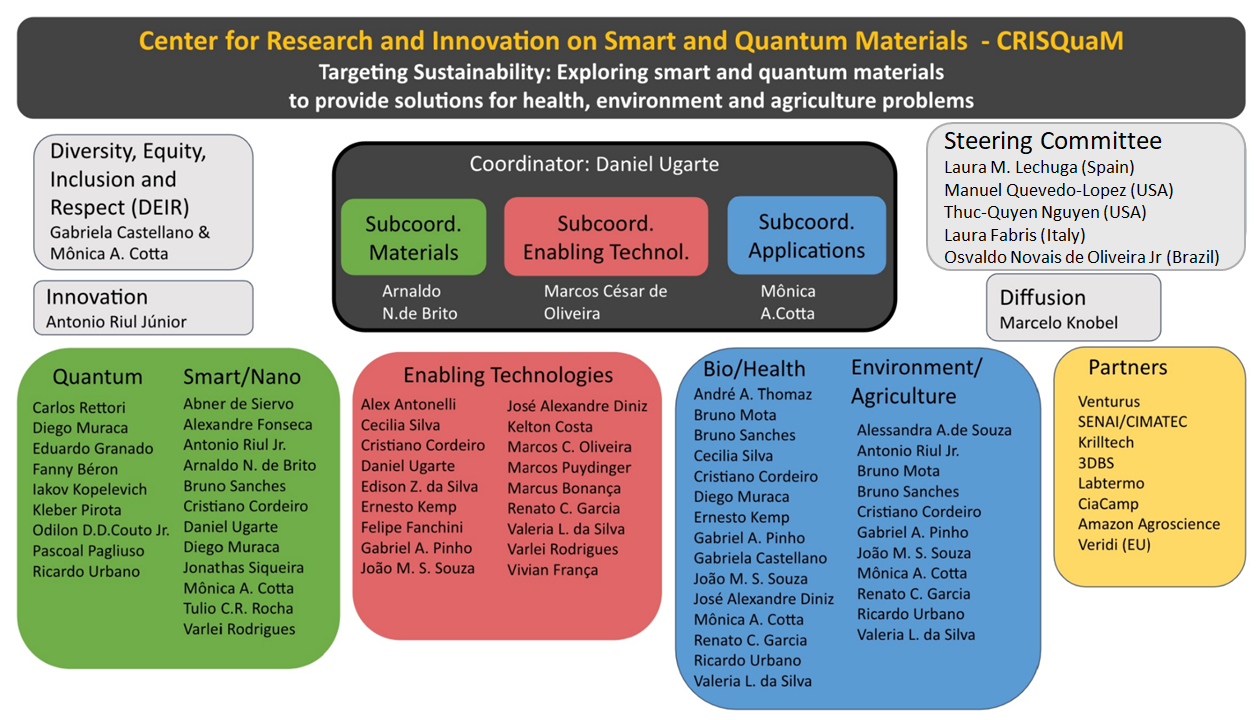BV-FAPESP: research projects supported in this Center
CRISQuaM in the Media: news about the center
CRISQuaM aims to explore the synergistic development of fundamental and applied science to create new materials with high potential for the construction of devices and sensors to address technological challenges related to sustainability, climate change, precision agriculture, ecology, and health. To achieve these goals, we have assembled an interdisciplinary and collaborative research team, integrating expertise across various scientific domains, researching novel materials with high innovation potential. By combining original synthesis methods, advanced characterization techniques, theoretical approaches, computational simulations, quantum technologies, and device construction designs, we aim to drive advances in smart and quantum materials, promoting scientific excellence and technological development. With this, we plan disruptive innovations in instrumentation—including hardware and AI-based tools—as well as in quantum technologies, biomedical devices, and signal processing, in addition to plant bionics, exploring plant-pathogen interactions. Besides research activities, we plan intensive actions in education, dissemination, and communication for the general public, as a modern society should be aware of the challenges humanity faces and how research and technology are essential for responsibly utilizing the planet's limited resources. CRISQuaM's Innovation activities are accelerated through partnerships with several companies in related technologies, many of them Brazilian. Finally, all activities of the Center are managed in accordance with diversity, equity, and inclusion goals and best practices.
The Center brings together scientists, engineers, and innovators in a collaborative effort to apply materials science and quantum technologies at the cutting edge, designing new materials and nano(bio)sensors for advanced diagnostics. The Center has a team capable of producing a wide range of (nano/micro) materials, along with precise chemical and physical characterizations using modern techniques (synchrotron, advanced microscopy, magnetotransport, magnetic resonance, optics, etc.). In addition, the team offers various options in enabling technologies, including miniaturization, processing, and additive manufacturing, as well as instrumentation, quantum sensing, and electronics development. Data analysis will employ updated approaches (numerical simulation, classical and quantum machine learning, and quantum optimization). Applications at the knowledge frontier will address urgent sustainability needs in environmental areas, precision agriculture, plant bionics, and biomedical interfaces, contributing to the development of local technologies in close partnership with the Brazilian industry.
The organization of the Center is based on three pillars — Materials, Enabling Technologies, and Applications — together with partner companies, as described in the figure below.

2025-07-16
Organoids were developed from the blood cells of centenarians who are part of a project conducted at the Human Genome and Stem Cell Research Center to discover genes that protect the brain from the effects of aging.
2025-07-16
Eurídice Monteiro, the former Secretary of Higher Education in Cape Verde, delivered the 5th FAPESP 2025 Conference. She argued that science is a tool for liberation, grounded in African contributions, cognitive justice, and South-South integration.
2025-07-16
Researchers at the University of São Paulo and Sapienza Università di Roma obtained the material without the need for high temperatures. The product has many potential applications, ranging from electronics to cosmetics.
2025-07-16
Researchers at the University of São Paulo extracted genetic material from animals kept in museums for a hundred years and from others living in the wild and concluded that they are a new genus with at least a dozen species. The group is working quickly to identify them all and direct conservation efforts in the Atlantic Forest, where they live.
2025-07-15
Developed at the University of São Paulo, the model uses protein expression to create a stemness index that analyzes the similarity of tumors to pluripotent stem cells. The article was published in Cell Genomics.
2025-07-15
Cross-referencing climate data and fossils from around 15 million years ago shows that the decline in prey availability may have played a role in the extinction of these felines. Another study cites competition with elephants and an increase in predators as factors that reduced the once diverse antilocaprids to a single species today.
2025-07-09
According to a study conducted by researchers in the state of São Paulo, Brazil, more deforested areas have fewer species that are more similar to each other and perform the same ecological functions. The authors say this phenomenon compromises the resilience of the ecosystem.